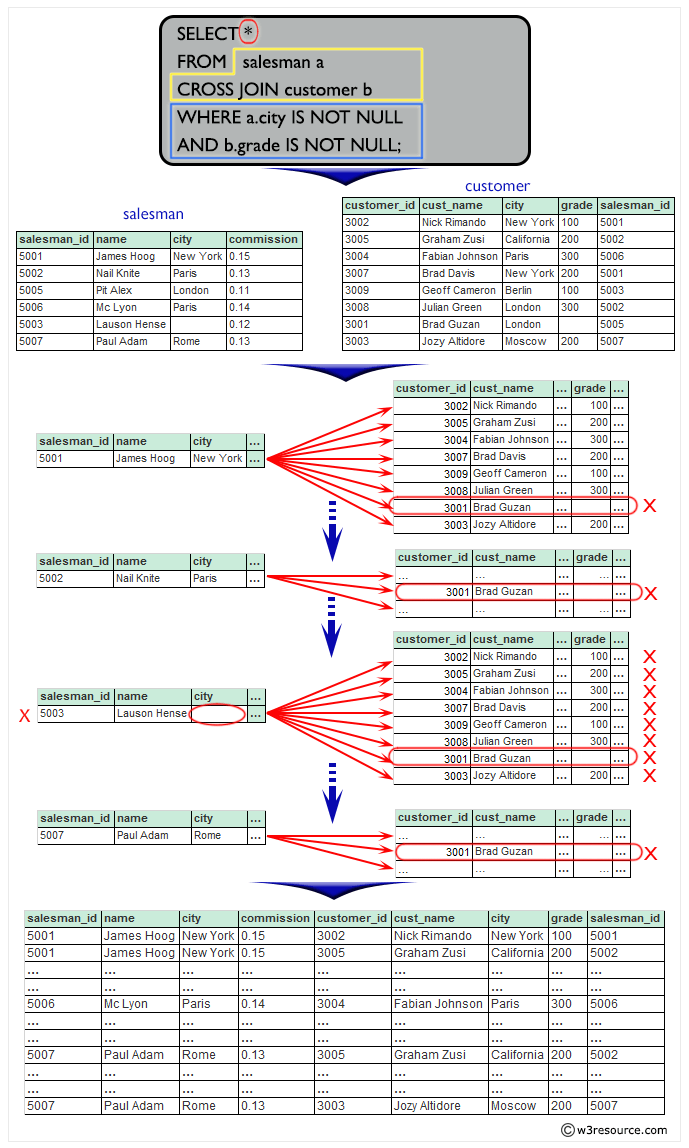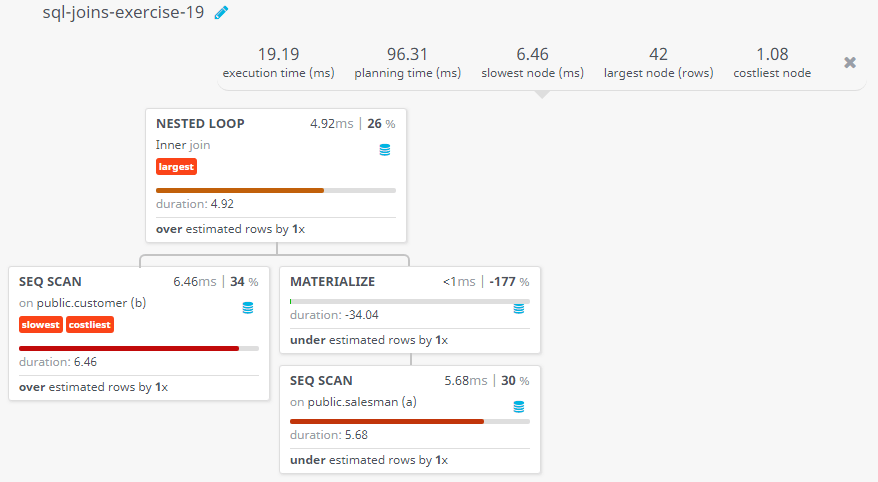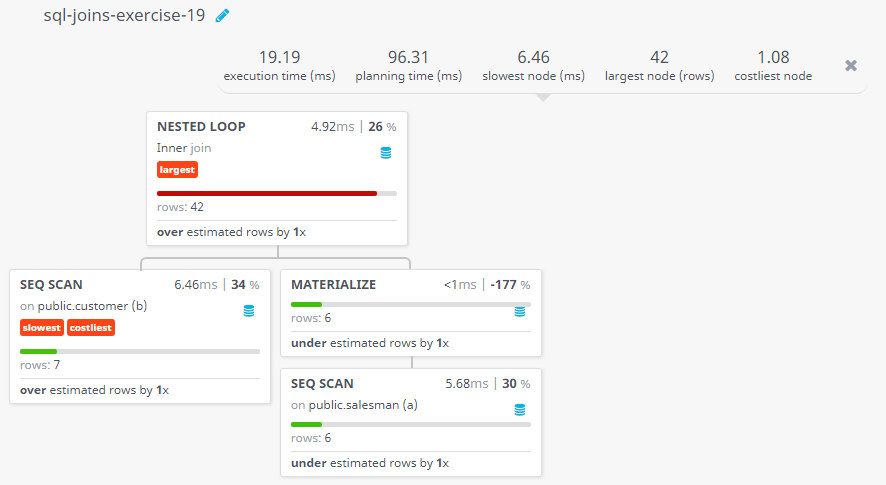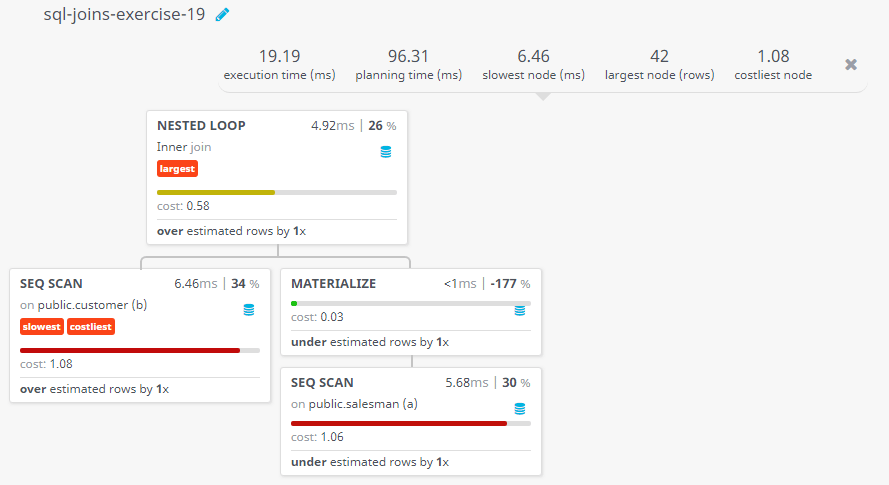SQL Exercise: Salesmen belongs to a city, customers have a grade
19. Cartesian Product with Valid City & Grade
Write a SQL statement to create a Cartesian product between salesperson and customer, i.e. each salesperson will appear for every customer and vice versa for those salesmen who belong to a city and customers who require a grade.
Sample table: salesman
salesman_id | name | city | commission
-------------+------------+----------+------------
5001 | James Hoog | New York | 0.15
5002 | Nail Knite | Paris | 0.13
5005 | Pit Alex | London | 0.11
5006 | Mc Lyon | Paris | 0.14
5007 | Paul Adam | Rome | 0.13
5003 | Lauson Hen | San Jose | 0.12
Sample table: customer
customer_id | cust_name | city | grade | salesman_id
-------------+----------------+------------+-------+-------------
3002 | Nick Rimando | New York | 100 | 5001
3007 | Brad Davis | New York | 200 | 5001
3005 | Graham Zusi | California | 200 | 5002
3008 | Julian Green | London | 300 | 5002
3004 | Fabian Johnson | Paris | 300 | 5006
3009 | Geoff Cameron | Berlin | 100 | 5003
3003 | Jozy Altidor | Moscow | 200 | 5007
3001 | Brad Guzan | London | | 5005
Sample Solution:
-- Selecting all columns from the Cartesian product of the 'salesman' and 'customer' tables
SELECT *
-- Specifying the tables to perform the cross join ('salesman' as 'a' and 'customer' as 'b')
FROM salesman a
CROSS JOIN customer b
-- Filtering the results based on two conditions: 'city' in 'salesman' is not null and 'grade' in 'customer' is not null
WHERE a.city IS NOT NULL
AND b.grade IS NOT NULL;
Output of the Query:
salesman_id name city commission customer_id cust_name city grade salesman_id 5001 James Hoog New York 0.15 3002 Nick Rimando New York 100 5001 5002 Nail Knite Paris 0.13 3002 Nick Rimando New York 100 5001 5005 Pit Alex London 0.11 3002 Nick Rimando New York 100 5001 5006 Mc Lyon Paris 0.14 3002 Nick Rimando New York 100 5001 5007 Paul Adam Rome 0.13 3002 Nick Rimando New York 100 5001 5003 Lauson Hen San Jose 0.12 3002 Nick Rimando New York 100 5001 5001 James Hoog New York 0.15 3007 Brad Davis New York 200 5001 5002 Nail Knite Paris 0.13 3007 Brad Davis New York 200 5001 5005 Pit Alex London 0.11 3007 Brad Davis New York 200 5001 5006 Mc Lyon Paris 0.14 3007 Brad Davis New York 200 5001 5007 Paul Adam Rome 0.13 3007 Brad Davis New York 200 5001 5003 Lauson Hen San Jose 0.12 3007 Brad Davis New York 200 5001 5001 James Hoog New York 0.15 3005 Graham Zusi California 200 5002 5002 Nail Knite Paris 0.13 3005 Graham Zusi California 200 5002 5005 Pit Alex London 0.11 3005 Graham Zusi California 200 5002 5006 Mc Lyon Paris 0.14 3005 Graham Zusi California 200 5002 5007 Paul Adam Rome 0.13 3005 Graham Zusi California 200 5002 5003 Lauson Hen San Jose 0.12 3005 Graham Zusi California 200 5002 5001 James Hoog New York 0.15 3008 Julian Green London 300 5002 5002 Nail Knite Paris 0.13 3008 Julian Green London 300 5002 5005 Pit Alex London 0.11 3008 Julian Green London 300 5002 5006 Mc Lyon Paris 0.14 3008 Julian Green London 300 5002 5007 Paul Adam Rome 0.13 3008 Julian Green London 300 5002 5003 Lauson Hen San Jose 0.12 3008 Julian Green London 300 5002 5001 James Hoog New York 0.15 3004 Fabian Johnson Paris 300 5006 5002 Nail Knite Paris 0.13 3004 Fabian Johnson Paris 300 5006 5005 Pit Alex London 0.11 3004 Fabian Johnson Paris 300 5006 5006 Mc Lyon Paris 0.14 3004 Fabian Johnson Paris 300 5006 5007 Paul Adam Rome 0.13 3004 Fabian Johnson Paris 300 5006 5003 Lauson Hen San Jose 0.12 3004 Fabian Johnson Paris 300 5006 5001 James Hoog New York 0.15 3009 Geoff Cameron Berlin 100 5003 5002 Nail Knite Paris 0.13 3009 Geoff Cameron Berlin 100 5003 5005 Pit Alex London 0.11 3009 Geoff Cameron Berlin 100 5003 5006 Mc Lyon Paris 0.14 3009 Geoff Cameron Berlin 100 5003 5007 Paul Adam Rome 0.13 3009 Geoff Cameron Berlin 100 5003 5003 Lauson Hen San Jose 0.12 3009 Geoff Cameron Berlin 100 5003 5001 James Hoog New York 0.15 3003 Jozy Altidor Moscow 200 5007 5002 Nail Knite Paris 0.13 3003 Jozy Altidor Moscow 200 5007 5005 Pit Alex London 0.11 3003 Jozy Altidor Moscow 200 5007 5006 Mc Lyon Paris 0.14 3003 Jozy Altidor Moscow 200 5007 5007 Paul Adam Rome 0.13 3003 Jozy Altidor Moscow 200 5007 5003 Lauson Hen San Jose 0.12 3003 Jozy Altidor Moscow 200 5007
Explanation:
The said SQL query is selecting all columns (*) from the table salesman as table a and the table customer as table b. It is then performing a CROSS JOIN, which combines every row from table 'a' with every row from table 'b'. The query is also filtering the results by only including rows where the 'city' column in table 'a' is not null and the 'grade' column in table 'b' is not null. Essentially this query will give the cartesian product of salesman and customer table where city and grade are not null.
Visual Explanation:
Go to:
PREV : Cartesian Product with City Flag.
NEXT : Cartesian Product with Non Matching Cities.
Practice Online
Query Visualization:
Duration:
Rows:
Cost:
Note: In certain instances not null is removed in table structure, so results may vary and the pictorial represetation above is based on such a table for the purpose of explanation only.
For more Practice: Solve these Related Problems:
- Write a SQL query to perform a CROSS JOIN between salesman and customer, filtering out rows where salesman.city is NULL or customer.grade is NULL.
- Write a SQL query to create a Cartesian product and use a WHERE clause to include only records with a non NULL salesman city and a non NULL customer grade.
- Write a SQL query to output the full combination of salesman and customer rows, applying conditions to ensure both have valid city and grade values.
- Write a SQL query to generate a Cartesian product and then filter the results with conditions on salesman.city and customer.grade.
Have another way to solve this solution? Contribute your code (and comments) through Disqus.
What is the difficulty level of this exercise?
Test your Programming skills with w3resource's quiz.




